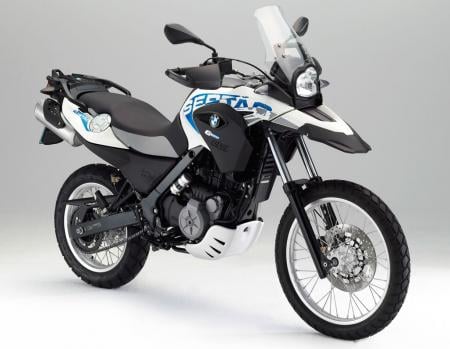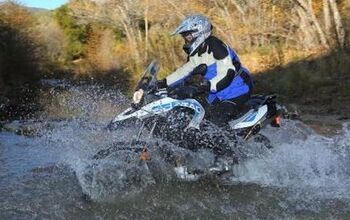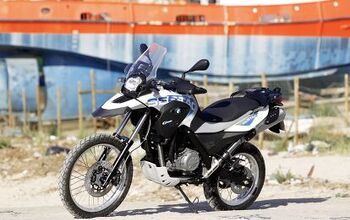2012 BMW G650GS Sertao Review - Motorcycle.com
BMW has a well-deserved reputation as a maker of rugged, all-terrain-conquering motorcycles that also serve as capable, good-mannered street machines. These days the bike that fills that image in most motorcyclists’ minds is the R1200GS. And for good reason: the big GS (and up-spec Adventure model) is a sales volume leader for the venerable German motorcycle manufacturer.
But the success of BMW’s two-wheeled adventuring ways doesn’t result solely from the glory-grabbing 1200GS or even the successful F800GS. There’s a humbler member of the Beemer family that’s contributed substantially to raising the profile of the GS lineup of motorcycles.
The 650GS Sertão: Even More GS in the Littlest GS
Modestly appointed by comparison to the 1200, the G650GS – powered by a 652cc Single – has been the first step into GS-land for lots of riders, starting way back in 1993 when this single-cylinder, chain final-drive (a serious break from the traditional BMW twin-cylinder platform at the time) was first born as the F650 Funduro.
For 2012 BMW has amped up the GS portion of the G650GS Kevin Duke recently reviewed, by creating a more off-road inclined stablemate, the G650GS Sertão. Named after the dry, hot region in Northeastern Brazil of the same name, BMW wanted to re-infuse the current 650 with the same adventurous spirit it gave to the F650GS in 2000 when the F650GS Dakar was crafted in honor of BMW’s successes in the Paris-Dakar Rally. BMW says the Sertão is the new Dakar.
The Sertão retains the same frame, brakes, instrumentation and 652cc Single from the standard 650GS. But giving the Sertão greater advantage in unpaved environments is: 8.3 inches of suspension travel (nearly 2 inches more than standard), spoked wheels (21-inch in front), hand guards, a 5.0-inch taller windscreen, steel lower engine guard and a 33.9-inch seat height (2.4-inch increase). A fork brace was added and the lower/inner fender removed, while the 1200GS-esque upper fender beak is a tad longer. And, for those counting, the Sertão’s 426-lbs wet weight is 4.0-lbs more than the standard G650GS.
While the standard G650GS is a known quantity to us on the street, BMW invited the moto media to a day of mixed riding environments to sample the Sertão. The day-ride started at the now famous and successful RawHyde Adventures riding school located near Castaic, Calif.
RawHyde focuses almost exclusively on creating anew, or improving upon, the off-road riding talents of motorcyclists, catering especially to BMW GS owners. Founder and proprietor, Jim Hyde, created the school in 2000 initially as a dirt bike/dual-sport training camp, but over the years Hyde discovered that within the GS community few owners of the world-traveling Beemer possessed the skills necessary to allow them to fully unleash the potential of the GS.
After years of successfully teaching off-road and adventure-type riding to the GS community, RawHyde became an official BMW training facility in 2008 – one of only nine BMW-endorsed schools in the world. Known as the BMW Off-Road Academy, RawHyde offers three levels of adventure-riding training, as well as a number of multi-day excursions, including the Continental Divide Ride – a nine-day journey along the spine of the Divide.
Hyde and his team have competed in the Dakar Rally, and plan to do so again in the 2012 event.
Hyde knows the capabilities of the G650GS, as well as the mountainous areas around his facility. A route that included miles of sometimes rough and rutted Jeep-type trails with numerous shallow water crossings along the way proved the proper dirty mixture to go along with plenty of paved-surface riding.
Adventure Worthy
In his review of the standard 650, Kevin refers to the bike as having a “highly cooperative chassis that presents no surprises,” which is aided by a wide, one-piece handlebar providing good steering leverage for “knife-like agility” when dicing up corners. These qualities remain in the Sertão. And despite its additional suspension travel, the front-end doesn’t dive excessively under braking.
Damping in the Sertão’s new long-travel sticks was ideal both on and off-road – impressive considering the fork lacks adjusters – while the 8-plus inches of travel smoothed out even the biggest ruts and rocks I encountered. Good suspension aside, 426 lbs is hefty by dirt bike standards. Yet that streetbike-sized figure didn’t prove a significant hindrance on the trails – the humble engine has the power to pull the bike’s weight out of greasy mud holes or up and over steep inclines, as evidenced by a handful of more daring journos’ antics during the day.
Further impressive, the Sertão’s street-biased Metzeler Tourance tires didn’t prove a serious disadvantage while off-road.
The G650 Thumper is counterbalanced to offset vibration inherent in a single-cylinder engine architecture. At speeds upwards of 80 mph the amount of engine vibes reaching the Sertão rider are minimal – a welcome trait when droning down the interstate. A flat, plentiful torque curve (44.2 ft-lbs at 7200 rpm as tested) means useful grunt early in the rev range with plenty of pulling power elsewhere, even when lugging along in higher gears.
However, despite near ideal gear ratios for street riding, I found myself wishing first gear had an even lower ratio than it already does when it came to picking my way through tighter, more technical off-road sections. The sometimes-finicky clutch combined with how quickly the bike can pull away in first gear made it challenging to finesse my way through portions of terrain that demanded near-crawling speeds.
To better enable slow speed maneuvering, first gear in the R1200GS Adventure is 10% shorter than first gear in the standard GS. I’d like to have seen a similar move made here between the Sertão and standard G650GS. However, this is nit picking and by no means a deal-breaker for the new G-GS. Clutch effort is notably light albeit with a too-early engagement for my preferences and the 5-speed trans clicks without a hitch.
A caveat to thoughtful riders says you may want to reposition the shift lever in order to get the toe of bulky motocross-style boots underneath the shift peg for less cumbersome upshifts.
Kevin admired the standard 650’s ergos, noting that its 30.7-inch seat height creates an environment welcoming of riders of shorter stature, especially for a bike with 6.5 inches of travel. The Sertão’s off-road biased suspension creates a seat height far less welcoming of short folks, and you won’t find a low seat option for the Sertão as you will for the standard 650GS. However, there is an optional tall seat (35.4 inches, $239).
I’m not the tallest geezer around, but even with my 30-inch inseam I found the Sertão’s seat height manageable when it came time to dismount or put a boot down during a stop – on and off-road. Additionally, the seat’s width and foam density made it a comfortable place to rest when I wasn’t standing on the footpegs (which offer the added convenience of a removable vibration-damping rubber insert).
Another add-on that may seem pricey when you don’t need it, but soon becomes worth its weight in gold when you do, is the heated grips option. Portions of the ride took us to elevations that saw several inches of fallen snow and near-freezing temps. On the high setting the grips produced enough heat to keep my winter-gloved hands feeling borderline hot. During the frigid route section I realized I would’ve gladly craigslisted something of value in order to have the factory-installed heated grips ($319 if purchased separately) on a Sertão I owned.
The new 650GS’s tall-ish windscreen is a genuine advantage in any scenario, since it offers increased wind deflection while bombing down the freeway, as well as providing some additional protection from debris kicked up by other riders when venturing off the beaten path.
Although numerous evolutionary changes to this BMW model over the past 19 years have given us the G650GS we know today, it has nevertheless remained at its core an approachable but highly capable motorcycle from BMW.
The Sertão is worthy of its GS badging.
Look for the G650GS Sertão in dealers in January 2012 with a base MSRP of $8650, or $8950 with the heated grips and power socket package.
Related Reading
2011 BMW BMW G650GS Review
2009 BMW G650GS Review
2011 Adventure-Touring Shootout: Triumph Tiger 800XC vs. BMW F800GS
All Things On-Off Road on Motorcycle.com
All Things BMW on Motorcycle.com
More by Pete Brissette

































Comments
Join the conversation